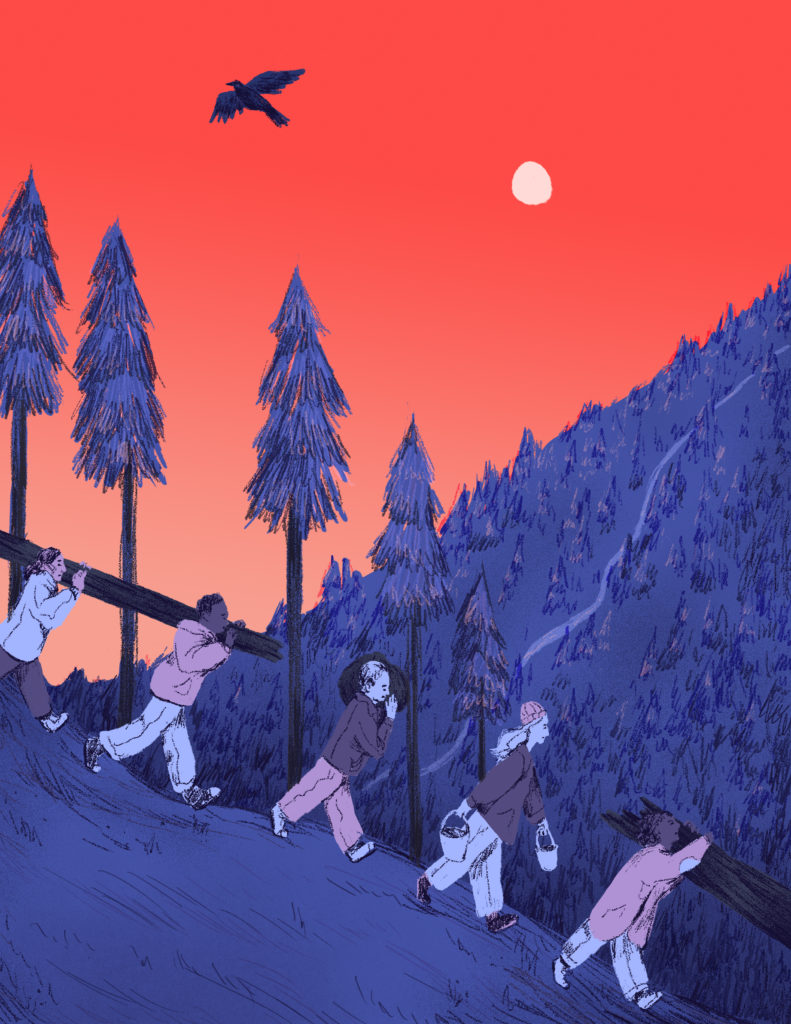
Illustration by Colleen Tighe. See more of her work here.
This article originally appeared in the Full Stop Quarterly’s special issue on graduate student organizing. You can support Full Stop’s work at our Patreon.
This past February 14th, members of the Resident Advisor/Peer Mentor bargaining unit of UAW 2322 (RA/PMU) at the University of Massachusetts Amherst made some very special valentines. After the UMass Amherst bargaining teamed canceled their Friday negotiating session Thursday night, union members took to crafts to express their displeasure, making “will UMass be my valentine?” card forms and anti-valentines that said things like “meh.” Supporters of the union moving off campus made break up cards with the Residential Life department, expressing their displeasure at how the union was being treated after months of drawn out negotiations, administration representatives cancelling and showing up late to bargaining sessions, and what the union has taken to be general disrespect towards the student worker negotiators.
Throughout the bargaining process, undergraduate Residential Life workers have pushed for healthcare, meal plans, higher wages, and, crucially, just cause for disciplinary procedures. For many members of the bargaining team, it’s the first time they have led negotiations, but they have already blocked the administration’s attempt to increase hours on Red Sox game days. The October organizing that led to this success and extended the union’s visibility through swift, vocal action strategically shifted student-worker outrage about the new hours into bargaining enthusiasm.
Since the Bernie Sanders campaign, the rapid growth of the American socialist left and nationwide teachers strikes have brought renewed attention to growing labor militancy and the expansion of unions to new populations of workers. There has been some sparse coverage of successful undergraduate unionization campaigns at private institutions like Grinnell College [1] and attempts to form them happening last year at Reed College and George Washington University, but these nascent unions have an important precedent—undergraduate inclusion in larger academic worker unions at public universities.
In March 2002 Undergraduate Resident Advisors (RAs) at University of Massachusetts Amherst joined United Auto Workers (UAW) Local 2322, which also represents UMass Amherst’s graduate students and post doctorate fellows as well as several other small shops across New England. UAW Local 2865, the University of California Student-Workers Union represents over nineteen thousand members across the system’s ten campuses, including not only graduate teaching assistants and research assistants, but undergraduate tutors and academic workers as well. These unions provide important models not just for the growing sector of undergraduate workers, but for graduate workers looking for creative strategies to build power in the face of attacks on the labor movement from right-wing politicians and growing corporate power.
Time for New Strategies
In the 1970s and 80s, federal work-study opportunities expanded, more and more graduating high school seniors entered higher education institutions, and tuition costs began to rapidly rise. A Bachelor’s degree became increasingly necessary as the youth labor market collapsed, and the percentage of college students who worked, and particularly who worked for their own school, rose. A 2015 Georgetown Center on Education and the Workforce report found that out of the roughly twenty million undergraduate students enrolled in college or university (including students at two- and four-year programs, at both nonprofit and for profit institutions), fourteen million worked, making up about 8% of the total US labor force and roughly three quarters of all students. While some students work off-campus, on-campus student workers, particularly at non-profit four-year residential campuses, are often on financial aid that requires work to attend school. Students not on aid often have few options for finding work outside of the campus community. Campuses are thus able to cultivate a pool of labor that is young, inexperienced, and captive—easily exploitable and low paid.
And yet these students are almost always unorganized.
Incorporating undergraduates into graduate unions, which are already mobilizing student workers on campus, is one potential method for organizing this growing labor force at institutions like research universities which have large contingents of graduate workers. I spent this fall semester talking to undergraduates, graduates, and union organizers in student employee unions, to try to understand how and why they would include undergraduates, both as a theoretical exploration of what it means to be a student worker and because of the practical implications this can have on higher ed organizing.
Graduate student worker identity is defined through their separation from and interrelation with other workers on campus, including staff, faculty, and especially other students, who they both teach and work alongside in similar roles. Questioning the bounds of what a student worker union can and should be necessitates questioning what it means to be a worker, what student identity entails, and, very fundamentally, what work is. If student workers are at once consumers, producers, and products of the university, how can we conceptualize their organizing needs? Understanding how both the university and its student worker unions define their bargaining units opens possibilities for new kinds of solidarity across divisions of labor, for rethinking historic divides between students and workers, and for creating new strategies for the labor movement that challenge historic exclusions, bringing in young, unorganized, and other traditionally excluded workers.
Considering these possibilities is becoming increasingly urgent. The 2018 Supreme Court Janus decision ruled that public sector unions cannot collect “agency fees,” which coupled with the decline in federal and state funding for public universities, means that graduate students on public campuses need to rethink engagement strategies. In the private sector, the National Labor Relations Board’s 2016 Columbia decision allowed graduate students (and undergraduate teaching assistants and researchers) at private universities to organize. But Trump administration appointments to the Board have meant that graduate unions worried about the threat of reversing Columbia can’t win recognition through traditional legal means, and thus need to consider creative tactics and to rethink how they build power on campus.
In this hostile climate, graduate unionization efforts’ relationship to undergraduates is a potential source of strength. There is already growing collaboration between graduate unions and undergraduate student activists, but undergraduates are a potential labor substitute for graduate workers. Winning strong contracts and enforcing them will have to rely on engaging in some form with undergraduates not just as students, but as fellow workers.
Unit Erosion
At many schools, from large public universities like the University of Michigan to private schools like New York University, graduate union contracts have been won only to see union jobs made into non-unit undergraduate work that can be paid less.
“It’s very pervasive,” Anaïs Surkin, a UAW 2322 organizer and former UMass Amherst graduate student told me. “In the GEO [Graduate Employees Organization] the unit erosion has two different faces. One is hiring undergrads to do GEO unit work and undergrads who are non-unit, because there is no unit for undergrad TAs, so hiring undergrad TAs or undergrad research assistants in a lab. [The other happens through classifying union work as hourly non-unit work.] . . . It’s been an issue for quite some time. There’s language in the contract that’s really old on undergrad TAs and I read that as probably, at some point, a GEO bargaining committee made a demand that no undergrad TAs will be hired and where that ended up getting settled would be that we get this report.”
The contract Surkin is referring to was made in 2001, but nearly twenty years there has been little change. Units at UMass-Amherst and across the country continued to be eroded as more and more undergraduates enrolled and universities boasted of opportunities for undergraduates to do research or receive one-on-one tutoring as teaching assistants.
These changes are hard to fight against because it is difficult to prove that job shifts weren’t necessary for reasons other than undermining the union (i.e., changing workplace mission, voluntary departures, new phases of research, etc.). This problem of unit erosion, which at least anecdotally appears to be widespread, is also difficult to even discuss because there is a significant lack of data. Nationally, and at specific schools, there is very little information on bargaining unit membership and changes linked to specific labs or workplaces. Even with numbers on student employment in specific classrooms and labs, proving causation is challenging since there are a number of reasons that graduate students with better contracts may not want to work in a specific workplace or might leave for reasons other than targeted unit erosion. More research is needed to provide empirical clarity on this issue, but, on an organizational level, incorporating undergraduates into the union is one potential means of preventing some of the more pernicious forms of labor substitution undermining graduate student contracts gains.
Of course, there are other solutions as well. Undergraduates work across the university from the classroom, to the cafeteria, to the print shop. They could be incorporated into the bargaining units of unions already organizing their specific workplaces. At schools closely linked to their surrounding metropolitan areas, like UMass Boston, a largely commuter school, units are eroded not just with graduate to undergraduate labor substitutions, but also from the school’s ability to draw in community members from the larger Boston area to take low wage non-unit jobs. At these schools, having better coverage for all workers in each job might be a potential solution. Schools that have strong unions representing their cafeteria or clerical workers for example might consider incorporating undergraduates in those workplaces into the bargaining unit, through clauses that allow part-time employees representation [2]. But in classrooms and especially lab settings, where undergraduates can be a cheap, if imperfect replacements for graduate labor, including undergraduates could have profound ramifications on the Academic Student Employees union’s ability to win and enforce strong contracts.
Anti-austerity through the Union
University administrations frequently couple their pushes to erode union workplaces with aggressive scarcity messaging. They attempt to link union strategies of making it impossible to replace high-cost work with low-cost work by raising all workers’ wages and benefits, to the threat of job cuts that schools will implement in response.
Across both the UMass and the UC systems, undergraduates have been instrumental in anti-austerity protests, especially in the face of decades of declining federal and state investment in higher education. Unions hold a key role in these protests, pushing back against the privatization of campus services and outsourcing of jobs. Student worker unions have resisted attempts by the university to divide the student body over a limited funding pool, fighting propaganda that paying living wages will require undergraduates to suffer. Graduate union organizing, and the labor movement as whole, has worked tirelessly against the pervasive notion that there is not enough to go around.
In the 1960s, Francis Fox Piven and Richard Cloward famously outlined a strategy to win concessions in such an environment, arguing for mass movements to overwhelm existing systems, forcing them to expand. They pushed back on the notion that a lack of funds meant something shouldn’t be used—rather if everyone eligible for a social service took advantage of it, the system would have to grow. This logic can potentially be applied to union contexts. There may be “no money for public schools,” but as workers face budget deficits, one approach to forcing higher state funding may simply be to demand higher wages. This strategy comes with obvious risks, given the success of scarcity narratives.
However, the pervasiveness and tenacity of scarcity narratives varies across schools, given their relative positioning and funding. The UC system’s Student-Workers Union encompasses all ten University of California campuses and in doing so organizes across a variety of funding structures and needs. Differences in wealth, prestige, and structure of the school do have important effects in how the local at various schools are able to approach undergraduate organization.
Many historians and labor studies scholars note that student protests and radicalism, from the 1960s onwards, have come at times when students were able to autonomously afford education and were less reliant on a conservative older generation. Melinda Cooper writes in Family Values that the Berkley Free Speech Movement was predicated on a foundation of free access to quality state funded higher education, which brought a broad coalition of independent young people into universities during the early 1960s. Conservative reactions to the 1960s student protests were based on spreading fears that they had “overspoilt” youth and pushed for higher university costs, pushing students, and, crucially, their families, into debt. This legacy has led to continued efforts in California since 2009 by students to push back against budget cuts. The fight against austerity had a radicalizing effect on the student workers movement.
“Both undergrads and grad students were very much part of this radical student movement and the building occupation,” Shannon Ikebe, a PhD candidate at UC Berkley and activist with Academic Workers for a Democratic Union (AWDU) and former executive board member, told me. “The union had been conservative, business-oriented before then and quite bureaucratic . . . But then the student movement led to the creation of this radical caucus called Academic Workers for a Democratic Union that took over the union leadership in the spring of 2011.” Union fights for better wages, benefits, and working conditions as well as struggles for affordable and accessible public education reinforce each other and allow students as both consumers and as workers to imagine bolder futures.
Not Just Allies
Student organizing has historically held itself apart from labor organizing, but since the rise of the New Left, the power of student and worker coalitions has become increasingly apparent. In the late 1990s, student labor solidarity groups like United Students Against Sweatshops (USAS) and the Student Labor Action Project (SLAP), formed and now have chapters on over 150 campuses across the country. As these groups have grown, unions of on-campus workers have drawn on student support to win better contracts. In 2016, UNITE HERE Local 26, which represents Harvard’s cafeteria workers, mobilized six hundred students for a walk out and later led 250 students to a sit in in the cafeteria. Two days after the sit in, the union was able to end the strike.
This supportive role and power that students hold as consumers and tuition payers at universities hasn’t gone unnoticed by graduate students. The 2005–2006 NYU strike mobilized undergraduates through Grad/Undergrad Solidarity (GUS), an auxiliary group to the union that involved undergraduates interested in labor activism by having them help educate their fellow classmates about the strike and graduate demands. GUS was an educational tool for students, and as Andrew Cornell writes in The University Against Itself, it was limited in its impact because of frustrations undergrads had with being excluded from decision making in union meetings, instead being confined to a supportive ally role that took on inordinate risk. To expand on Cornell’s analysis, it seems graduate student unions often work with student groups on campus to garner support, and convince students that they too share an interest in their TA’s being well paid and well treated because it will increase their quality of education, but do not take the step of showing undergraduates that both have a common interest as workers. Much like university administrators, graduate students are not immune from seeing undergraduates as students and consumers, not workers.
Working, and Organizing, with Undergraduates
In March 2002 Undergraduate Resident Advisors (RAs) at UMass-Amherst joined UAW Local 2322, which, after forming in 1990, also represents UMass-Amherst’s graduate students, post-doctoral fellows, and several other small shops across Massachusetts. The undergraduates had been organizing since 2000 and, after a year and a half of work, on March 5, the union won a recognition vote of 138–88 (out of 365 possible RAs). The UMass-Amherst RAs won recognition in July [3] and by the fall of 2002 had begun contract negotiations.
The Peer Mentors joined the local in 2014. In fall of 2011, the Peer Mentors, who live in dorms and serve as student academic advisors and support systems to incoming first years, were told that their jobs were going to be eliminated. They quickly organized, protesting and working with UMass Amherst’s GEO, and their positions were restored for the 2012–2013 academic year. Throughout the organizing drive, as undergrads collected cards and prepared for an election, they met with and worked alongside UMass Amherst’s GEO. Now, five years after the Peer Mentors joined the union, the grad and undergrad units continue to work together through mentoring and issue-based campaigns, like a current drive against hunger and food insecurity.
A significant challenge for existing graduate student unions is moving to incorporate undergraduates, who tend to be younger, less educated, and have less organizing experience. Moreover, they must ensure that they are respected and given dignity within the union and that they and their interests are represented within the union.
Ikebe explained that, while it hasn’t been an explicit political issue within the UC union, there were big questions of representation and balance to contend with. “How do we make sure the union isn’t dominated by the grad workers who may have different interests. . . . because the workplace is the same and the employer is the same there are a lot of benefits to [having undergraduates in unions with graduate student workers]. But the question of democracy is one we have to take seriously,” he told me.
Undergraduates in UMass’ Local 2322 make up their own bargaining unit. They have their own elected officials and as of this semester, their own steward program. Many of the students I spoke with at UMass Amherst were satisfied with their bargaining units being split along student status, not sector of work, largely because they felt it gave undergraduates some autonomy.
“They can have their own leadership positions and their own everything and they are still in a local with the grad students because that does help them a lot both in terms of resources and relationships, and in terms of solidarity and doing campaigns together,” said Surkin. She worried that having GEO and the RA/PMU share a single bargaining unit might limit undergraduates’ engagement and their ability to be listened to, given that there are fewer of them involved in the union than there are graduate students.
This fear is not entirely unprecedented. The UC system also includes undergraduates in the Student Worker Union, but decides who is eligible for the local based on what type of work they do, not by graduate or undergraduate status. Units include both graduate students and undergraduates, although students are compensated differently depending on whether their job is classified as being a tutor or TA. Roughly 16% of the bargaining unit across the UC system is undergraduate (the percentage of undergraduate workers vary by school), though far fewer eligible undergraduates join the union than eligible graduate students. One of the many factors contributing to the underrepresentation of undergraduates in the union is underrepresentation of undergraduates in leadership positions. In the last four years, there have been no undergraduates on the executive board.
“Only undergrads who are working as tutors are eligible to join, so it’s already a small proportion of undergrads. It’s a very temporary job . . . so that’s one of the structural difficulties to attract undergrad activists because grad students can be members of the union even when they are not working (which at other unions is very different),” Ikebe explained. But there is also the problem of “the identity of the union. It can be seen as a grad union . . . for the past year or two we have been more careful than before not to refer to it as a grad union. We are a student workers union, that’s the name and we use it to make sure we cover both undergrads and grads, but there is still an identity or culture that we are a grad union which may not help in that regard.”
Though attempts to incorporate this important minority of undergraduates into the larger locals has consequences on their abilities to self-govern or have adequate representation, the UAW 2865 model of structuring the union has significant advantages. Theoretically, it makes unit erosion more difficult when student workers who share the same job are part of the same union, because the potential for substituted labor is severely limited. To have a credible majority strike, the union needs the one sixth of teaching assistants and tutors that are undergraduates to participate.
UMass Amherst’s model allows for solidarity, mentoring, and collective action, but very few graduate students in GEO (only the approximately fifteen serve as supervisors in Reslife) share a direct employer, workplace, or job description with the RA/PMU. They haven’t organized undergraduate Teaching Assistants and over the last sixteen years, unit erosion has continued to be a pervasive problem at UMass Amherst. Since undergraduate TAs are unorganized, there is little the GEO can currently do to prevent non-unit substitution, but Surkin explained that, “for years we’ve been talking about what to do about it and the general consensus is we should organize all student workers on campus . . . so far no one’s done anything to do that, but it’s the consensus as the solution.”
This organizing would of course come with challenges. Undergraduates are difficult to organize. They share many of the same problems that graduate students do, like having a high degree of transience and limited institutional memory and are often similarly spread throughout campus in diffuse workplaces. The university takes on a patriarchal role for many of its workers, creating a sense of family and using language around community to create a sense of belonging and allegiance for the workers it employs. This can be especially true for undergraduates, who come into the university not primarily thinking of their relationship to it as one of an employee to an employer. Undergraduates living within the university are fed and “cared for” by it, using university housing and medical serves. Programs like the UC’s Academic Enrichment Program, a diversity engagement and mentoring programing, which, like nonprofit work, carries a sense of larger mission, creates loyalty and desire in students to want to volunteer their time toward the program. Similarly, ResLife at UMass Amherst uses discussions of community and belief in the mission of the program to enforce a sense of allegiance.
This dedication to their jobs may often be a point of commonality with graduate workers. “Everybody has a kind of emotional investment in these jobs. Most people don’t see it as just a job, most people are really passionate or really care about their residents in Reslife, or research in a lab, or teaching,” Surkin explained. “That gets exploited and manipulated by the administration in different ways . . . but that actually galvanizes a lot of people who see the differences between what ResLife management says [about community and care] and what ResLife actually does.”
Including undergraduates in the union also sometimes means bringing people who manage each other into the same local. At UMass Amherst, roughly fifteen graduate ResLife workers participate in GEO serving as the managers of the undergraduate RA/PMU. The tension this creates is largely alleviated by separate units and the limited power of the graduate ResLife workers in the larger context of GEO but the potential conflicts of interest that could arise are one of the reasons they have not yet organized undergrad TAs or lab assistants, who would work below GEO members.
Organizing undergraduates into the same union as graduate students isn’t the only solution to unit erosion and it isn’t the only way to build power on campus. But there is a very real need for undergraduate organization, a real potential for it to support graduate employees, and a danger of dual unions that makes this solution an attractive one.
Lessons and Homework
Across the UC system, in the lead up to their recent round of contract negotiations and in preparation for Janus, the student worker union’s executive board rolled out a program called March to Majority, which focused on bringing areas with low union membership to becoming majority union shops. Many of these shops focused on during last year’s March to Majority were undergraduate areas, and over the course of the year there was a slight rise in the inclusion of undergraduates.
This spreading interest in undergraduates is also resulting in renewed efforts to engage undergraduates at UMass Amherst. In the last two years greater attention has been paid to strengthening the RA/PMU and the connection between the graduate and undergraduate units.
This investment makes a big difference to undergraduate workers. “There’s solidarity in terms of trying to devote resources and time. Sometimes members from the graduate employee organization may come to bargaining, may help train people here and there and one of the really big things as well is we [GEO] look at a lot of their contract language and their bylaws and things like that to help shape what the Resident Assistant and Peer Mentor Union should look like,” Mitch Manning, a current organizer who works with the RA/PMU and graduate student and former undergraduate RA at UMass Amherst, told me. “Because there are staff positions for the graduate employee organization, there are people who have been working within a union setting for longer than people who are co-chairs [of the RAPMU], where there’s higher turnover. A lot of the time, at least when I was a co-chair, when I had a question about what I should do or what would be a good idea or a good meeting to have or a good event I would speak with the graduate employee organization staff and get some training from them. I was taught by the grievance coordinator how to do grievances because that was a dedicated position that GEO has.”
Strong connections between student workers on campus can strengthen undergraduate organizing. But it can also help graduate students’ union efforts. The UMass GEO and RA/PMU are currently working together to fight food insecurity on campus and stop rising fees. The UC local settled a contract this summer, a process which relied on and was strengthened by their undergraduate workers’ support.
As graduate workers look for support on campus, they must start looking to other student workers. Labor solidarity organizations like SLAP and USAS can be vehicles for getting students involved in the labor movement as workers. Peer Mentors joined the UMass Amherst local after being organized by students like Jenna Grady, who had gained experience from previous work with SLAP campaigns. And though mobilizing undergraduates can be difficult, graduate workers frequently have the advantage of regularly encountering undergraduates through their jobs as Teaching Assistants. Taking the time to explain how they work and what their union is can be instrumental to helping undergraduates recognize their own labor and role as campus workers, inspiring them to organize. In fact, more that than calculus or the history of economic thought, explaining the union to undergraduates might just be the most important lesson they can share.
1. In late 2018 the Grinnell Student Workers union decided to include all undergraduates in its bargaining unit, nearly leading to an appeals process that would have challenged all private school student workers ability to unionize, but withdrew the broader petition.
2. UC Berkley’s undergraduate dining hall workers organized into what they called the Undergraduate Workers Union (UWU) in March 2017. They met with the Student-Workers Union but organized separately from both professional non-student food services staff and the undergraduate tutors in UAW 2856, raising questions of whether undergraduates should organize by workplace or by student status.
3. In the initial petition and vote, the unit included 12 graduate workers who were also ResLife employees, but served as managers for undergraduates. Those 12 votes were challenged and are currently part of the GEO.
Emma Rose Borzekowski is a recent graduate of Wesleyan University interested in environmental policy and labor organizing. She wrote a thesis on undergraduate unionization tactics and planned a conference for undergraduate student workers in summer 2019.
This post may contain affiliate links.







